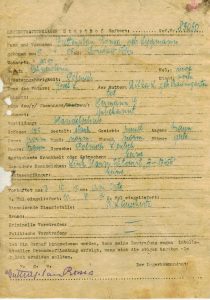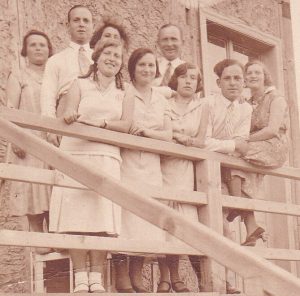
Häftlingskarte Ronja Guttenplan, KZ Stutthof
Text / Tekst in DE / EN / PL
[DE] In Münster fand ein Prozess statt gegen einen früheren SS-Wachmann des Konzentrationslagers Stutthof (etwa 50 km entfernt von Danzig); die Regionalschau Münster berichtete darüber. (WDR-Münster über das KZ Stutthof)
read more / Czytaj więcej >
In unserer Ausstellung über den Holocaust im galizischen Erdölrevier dokumentieren wir vor allem das Schicksal der jüdischen Familie Lippman. Ronya (Ronja) Guttenplan war die Tante des Überlebenden Prof. Józef Lipman. Als die Nazi-Besatzung angesichts der heranrückenden Roten Armee die Erdölstadt Boryslaw aufgab, löste man das Zwangsarbeitslager für Juden auf und brachte die noch lebenden arbeitsfähigen Juden in das KZ Krakau-Plaszów. Von dort wurde Ronya Guttenplan in das KZ Auschwitz transportiert, wo sie am 8.8.1944 unter der Häftlingsnummer A_17456 registriert wurde. Am 10.9.1944 wurde sie dann in das KZ Stutthof überstellt (Häftlingsnummer #85050). Dort kam sie um: ob durch Entkräftung, Hunger, Krankheit, Misshandlung oder Spritze ins Herz lässt sich nicht mit Sicherheit sagen.
Der Prozess wurde jetzt wegen des Gesundheitszustandes des Angeklagten vorzeitig beendet (WDR-Münster über das Prozessende). Trotzdem war es in jedem Fall gut, dass durch diesen Prozess noch einmal an die Ermordung der Juden in diesem KZ erinnert wurde. Für uns verbindet sich dieses grausige Geschehen auch mit dem Bild von Ronya Guttenplan.
[EN] A trial against a former SS guard of the Stutthof concentration camp (about 50 km away from Danzig) took place in Münster; the Regionalschau Münster reported on it.
In our exhibition on the Holocaust in the Galician oil district, we document above all the fate of the Jewish Lippman family. Ronya Guttenplan was the aunt of the survivor Prof. Józef Lipman. When the Nazi occupation abandoned the oil town of Boryslaw in the face of the approaching Red Army, the forced labor camp for Jews was dissolved and the Jews still alive and able to work were brought to the Krakow-Plaszów concentration camp. From there, Ronya Guttenplan was transported to the Auschwitz concentration camp, where she was registered on 8 August 1944 under prisoner number A_17456. On September 10, 1944, she was transferred to the Stutthof concentration camp (prisoner number #85050). There she was killed: whether by

Familienfoto vor 1939; Ronja Guttenplan ganz links
exhaustion, hunger, illness, abuse or injection into the heart cannot be said with certainty. In any case, it is good that this trial once again reminds us of the murder of the Jews in this concentration camp. For us, this horrible event is also connected with the image of Ronya Guttenplan.
[PL] Obecnie w Münsterze toczy się proces przeciwko byłemu strażnikowi SS z obozu koncentracyjnego Stutthof (ok. 50 km od Gdańska), o którym informuje dziennik regionalny z Münsteru.
Na wystawie poświęconej Holokaustowi w galicyjskim okręgu naftowym dokumentujemy przede wszystkim losy żydowskiej rodziny Lippmanów. Ronja Guttenplan była ciotką ocalałego prof.Józefa Lipmana. Niemcy uciekając przed zbliżającą się Armią Czerwoną, tuż przed opuszczeniem miasta naftowego Borysław, likwidują obóz pracy przymusowej dla Żydów, a Żydów wciąż żyjących i zdolnych do pracy przewożą do obozu koncentracyjnego Kraków-Plaszów. Stamtąd przewożą Ronję Guttenplan do obozu koncentracyjnego Auschwitz, gdzie 8 sierpnia 1944 r. została zarejestrowana pod numerem więźnia A_17456. Następnie 10.9.1944 r. przenoszą ją do obozu koncentracyjnego Stutthof (numer więźniai #8505050) gdzie zmarła: czy to przez wyczerpanie, głód, chorobę, maltretowanie czy zastrzyki do serca, tego nie można z całą pewnością stwierdzić. W każdym razie dobrze się stało, że ten proces po raz kolejny przypomina nam o zabójstwie Żydów w tym obozie koncentracyjnym. Dla nas to makabryczne wydarzenie jest również związane z obrazem Ronji Guttenplan.
Schreibe einen Kommentar